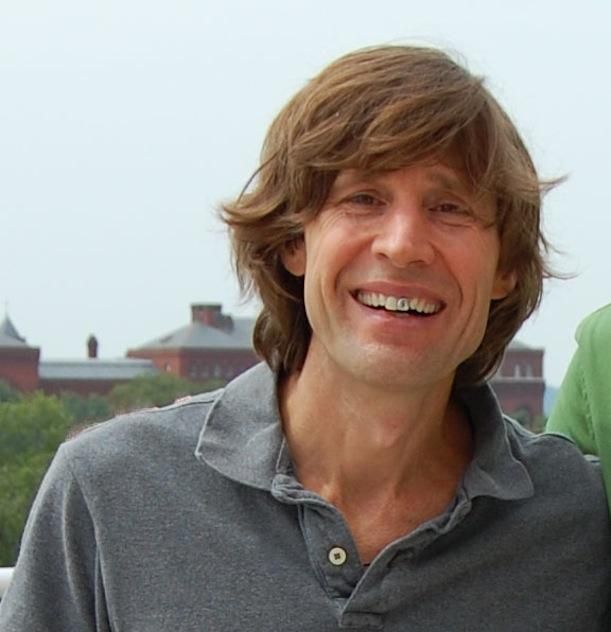4 Tips for Inventing the Next Great Skateboarding Trick, Courtesy of Tony Hawk and Rodney Mullen
The skateboarding legends will be at the American History Museum this weekend to talk about innovation in their sport
/https://tf-cmsv2-smithsonianmag-media.s3.amazonaws.com/filer/Hawk-air-thumb.jpg)
Tony Hawk and Rodney Mullen are skateboarding giants. Both turned pro in their early teens more than 30 years ago, and spent the 1980s and 1990s pioneering modern skating’s two most prevalent styles: Hawk, “the Birdman,” took to the skies to invent many of the sport’s iconic gravity-defying aerials, including the 900; Mullen, “the Godfather of Street Skating,” hit the pavement to make up flips, grinds and balancing maneuvers that don’t seem humanly possible even after you’ve watched them.
Combined, the two have come up with close to 100 tricks.
The pair will be at the National Museum of American History this weekend for Innoskate, a public festival that celebrates skateboarding’s culture of innovation, from tricks to skateboard design to skate shoes and fashion. After Hawk donates his very first skateboard to the museum’s collection on Saturday, he will sit down with Mullen for a panel discussion specifically about trick innovation, during which the two legends will reflect on the challenges and rewards of imagining the big moves that launched their sport from a small, alternative subculture to a mainstream sensation.
In anticipation of this discussion, we asked Hawk and Mullen separately what it takes to invent a killer skateboard trick. Here are the four golden rules we took away from their responses:
1. Respect the Past
“When I came up with most of my tricks, it wasn’t like I was trying to figure out the next move that was impossibly difficult and had never been tried on any level.,” Hawk says. “A lot of the things I’ve created, especially throughout the ’80s, combined existing tricks.”
He invented his first trick, the backside varial, at about age 12. The trick wasn’t earth-shattering, but it was new, and gave Hawk an original move to begin to establish his credibility at such a young age.
“For me, skating wasn’t always about the chase of being the inventor,” he says. “I just wanted to keep improving my skills, and if I could take inspiration from others to do that, I was happy to.”
Mullen had a similar experience in creating one of his most significant early-career tricks, the casper. The move was a slight alteration of what was already known as the 50-50 casper, in which the skater flips the board upside down and balances it with only the tail touching the ground.
“In many ways, that move opened up so many variations,” he says. “But at the time, it was a very, very simple variation itself of what already existed—so much so that it just dropped the 50-50 and used the same name.
“Everything is a variation of a variation, to some degree” he adds. “You can’t expect to come up with something and say, ‘that’s entirely new.’ ”

2. Stay Simple
Great tricks don’t need to be complicated, Hawk and Mullen agree. Instead, the best tricks combine technical proficiency with an element of grace—a certain harmony of imagination and function.
Hawk says that many of his tricks have been “born out of necessity,” the accidental result of trying to accomplish one move and realizing there was a different way to approach things. He came up with the backside varial, for instance, because he was bad at frontside rotations.
“Sometimes I would be trying to learn something that had already been created and my board would keep getting away from me or I felt like I was turning too far, and I’d think, oh, maybe I could do something new here,” he says.
Mullen jokes that “the greatest skaters are the laziest skaters.” For a lot of the tricks he has invented, he says, “my line of reasoning has been it’s going to be 10 percent harder, 20 percent harder, 30 percent harder to do at first, so it costs more upfront to get there, but in the end, if I can count on it more, then it will be easier. That is what has driven a lot of my thinking in terms of what got me to do things a little differently.”

3. Keep an Open Mind
“Usually skaters are stubborn, because they don’t like to be defeated, but that’s something you really have to let go of sometimes,” Mullen says. “If you approach a hard new trick with a mindset of ‘I’m going to overcome this, just turn on the camera,’ you’re probably not going to hit the trick because it’s going to be an uphill battle. Put away the camera and say, ‘I’m just going to tinker with this. I’m a little bit at sea, and I’m going to go with the tides and see where they take me.’ ”
And letting go doesn’t mean settling for anything less. “Open your mind to doing something even harder, too,” he says. “If your environment spins you in a certain direction or gives you a certain torque that works against you in one way, it may work for you in another. Even if a trick is 20 percent harder, if it flows better with the environment you’re skating in, it might actually be easier to do. So just go with it. Play with it. Maybe you won’t get what were dreaming of, but you might be able to get something better.”
Hawk likes to go back to the basics whenever he hits a rough patch.
“I would do tricks that felt good but weren’t necessarily as hard, and tinker with them,” he says. “With grinds, for example, I would think, all right, what’s the limit of these types of grinds? What can we do with them, instead of trying to figure out the next super crazy flip spin. I created a lot tricks by going back to the drawing board, because people don’t always think in those terms.”
4. Be Authentic
“I can do the exact same trick somebody else does and it will look completely different, because I have my own my own flair,” Hawk says. “Skating is about sharing ideas, but at the same time making it your own. It is equally creative as it is athletic, as much an art form as it is a sport.”
“Authenticity is everything in the community,” Mullen agrees, and adds that skateboarding culture is unique in its lack of metrics to define what is good skating and bad skating, proper and improper form; rather than conforming to standards, individuals contribute to the community by developing their own style.
“Be yourself,” he says. “If you have this kind of spastic way of doing something, even if it looks goofy, the fact is that it can look cool, because it’s you. Go with that. Be different. Don’t just try be different and concoct it, because you’re going to be sniffed out.”
“Do what you love, even if it’s not established,” says Hawk. “And keep doing it, because you might be the pioneer of a whole movement.”
/https://tf-cmsv2-smithsonianmag-media.s3.amazonaws.com/accounts/headshot/paul-bisceglio-240.jpg)
/https://tf-cmsv2-smithsonianmag-media.s3.amazonaws.com/accounts/headshot/paul-bisceglio-240.jpg)